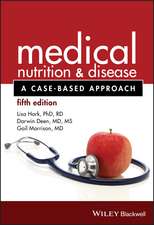Controlled Hypotension in Neuroanaesthesia
Editat de D. Heuseren Limba Engleză Paperback – 6 oct 2011
Preț: 369.29 lei
Preț vechi: 388.72 lei
-5% Nou
Puncte Express: 554
Preț estimativ în valută:
70.66€ • 73.78$ • 58.48£
70.66€ • 73.78$ • 58.48£
Carte tipărită la comandă
Livrare economică 04-18 aprilie
Preluare comenzi: 021 569.72.76
Specificații
ISBN-13: 9781461295129
ISBN-10: 1461295122
Pagini: 244
Ilustrații: X, 230 p.
Dimensiuni: 178 x 254 x 13 mm
Greutate: 0.43 kg
Ediția:Softcover reprint of the original 1st ed. 1985
Editura: Springer Us
Colecția Springer
Locul publicării:New York, NY, United States
ISBN-10: 1461295122
Pagini: 244
Ilustrații: X, 230 p.
Dimensiuni: 178 x 254 x 13 mm
Greutate: 0.43 kg
Ediția:Softcover reprint of the original 1st ed. 1985
Editura: Springer Us
Colecția Springer
Locul publicării:New York, NY, United States
Public țintă
ResearchCuprins
I Pharmacological and Toxicological Aspects of Drugs Used for Induction of Hypotension.- Pharmacology of Drugs Used in Elective Hypotension for Neurosurgery.- Specific Vascular Mechanisms of Hypotensive Acting Drugs.- Rebound Arterial Hypertension Following Discontinuation of Sodium Nitroprusside: Aetiology and Prevention.- Is There Still Any Indication for Application of Volatile Anesthetics During Induction of Hypotension in Neurosurgery?.- Interactions of Anesthetic Drugs and Muscle Relaxants with Those Drugs Commonly Used for Controlled Hypotension.- II Cerebral Blood Flow and Metabolism Under Conditions of Systemic Hypotension.- Direct and Indirect Cerebral Effects of Deliberate Hypotension.- Autoregulation of Cerebral Blood Flow: Effects of Hypotensive Drugs.- The Deleterious Effect of Excessive Tissue Lactic Acidosis in Brain Ischemia.- Interaction Between Blood Glucose Level, Degree of Cerebral Tissue Acidosis and Cellular K+ Release Under Critical Cortical Flow Conditions.- Controlled Hypotension in Neuroanesthesia.- Membrane Stabilization in the Ischemic Brain: A Mode of Protection?.- Blood Flow and Oxidative Metabolism of the Young Adult and Aging Brain.- III Cerebral Electrical Activity During Systemic Hypotension in Neuroanesthesia.- Electrical Monitoring of the Brain in Induced Hypotension — An Introduction to the Session.- Critical Comparison of Monitoring EEG, Cerebral Function (CFM), Compressed Spectral Array (CSA) and Evoked Response Under Conditions of Reduced Cerebral Perfusion.- The Use of Somatosensory Evoked Potentials in Neurosurgical Practice.- Recent Aspects of Hypotensive Drug Effects on Intracranial Pressure.- IV Morphological Aspects of Controlled Hypotension.- The Neuropathology of Stagnant Hypoxia.- Structural Changes in the Brain DuringCritical Reduction of Blood Flow or Oxygen Tension.- The Significance of Low O2 Tensions in the Brain Cortex for Occurrence of Metabolic Alterations Under Critical Flow Conditions.- V Clinical Aspects of Controlled Hypotension.- Variations of the Instantaneous Heart Rate During Neuroleptanesthesia with Concomitant Continuous Infusions of Althesin and Sodium Nitroprusside.- Limitations of Induced Hypotension.- Pro and Contra Hypotension in Neurosurgery.- Chairman’s Summary.- List of Principal Contributors.















